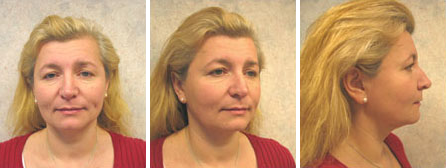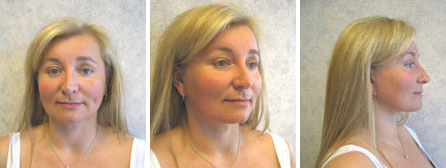Facelift
Ageless Impressions – Plastic Surgery Institute has been specializing in facelifts, cheek lifts, and other facial plastic surgeries for years. The expertise and dedication of board-certified plastic surgeon Mark Richards, M.D. and his professional staff have led to the satisfaction of many facial plastic surgery patients. In addition to exceptional results, we are dedicated to patient comfort, education, and understanding. Please read about the facelift procedures below to better understand your facelift options. If you are seeking a facelift, please contact our office today.
Facelift Surgery at a Glance
- Sedation: A combination of general and local anesthesia
- Potential Benefits: A more refreshed, youthful facial aesthetic; dramatic reduction of jowls, skin folds, excess facial/neck fat, and other common concerns
- Potential Risks: Swelling, bruising, scarring, numbness; (less commonly) bleeding, infection, adverse reactions to anesthesia
- Procedure Length: Approximately five hours
- Recovery Time: Most patients can return to work within two weeks and more strenuous activity within a month
- Cost: From approximately $12,900
Before

After

View Our Photo Gallery
What Is a Facelift?
A facelift involves repositioning the multiple deeper layers of the lower half of the face and neck to restore the facial shape and definition combined with a gentle tightening of the skin. Restoration of the neck is normally performed at the same time to provide a unified look to the lower half of the face.
A facelift can be an excellent way to reverse these signs of aging. The procedure involves repositioning the multiple deeper layers of the lower half of the face and neck to restore the facial shape and definition combined with a gentle tightening of the skin. Restoration of the neck is normally performed at the same time to provide a unified look to the lower half of the face; alternatively, cheek lift techniques can be incorporated to rejuvenate the mid facial and lower eyelid contours.
Complementary Procedures to Facelift Surgery
The term “facelift” is sometimes applied to several different surgical techniques. However, facelift surgery results are best achieved by operating on the deeper structures of the face to elevate both skin and fat compartments through tightening the muscle lining that is strongly attached to the facial skin and fat. Other surgeons may offer a type of facelift that focuses only on tightening the skin. Unfortunately, this version of facelift can distort facial features and its results tend to diminish quickly with time. Our facelifts tend to produce long-term, natural results.
Others erroneously believe that a facelift can improve skin texture or superficial skin wrinkles. On the contrary, simply stretching out the skin to rid it of lines often looks unnatural and alters facial features by stretching and flattening them. Instead, a facelift is meant to tighten the underlying tissues in order to restore facial structures and contour shape. Some trimming and tightening of the skin does occur in a facelift, but the effect is intended to be subtle and natural-looking. For improvement in skin texture, procedures such as dermabrasion, injectable dermal fillers, microneedling, or chemical peels can be combined with a facelift (or used in isolation).
In addition, a facelift is not meant to treat all areas of the face. The nose, for example, is altered with a different procedure called rhinoplasty. Similarly, the eyes and forehead are best served with procedures designed specifically for them. Dr. Richards evaluates your face as if it is divided in thirds (upper eyelids and above are the top third, lower lids and cheeks are the middle third, and the corner of the mouth through the neck are the bottom). Facelift is mostly only beneficial for the bottom third. The middle section requires a cheek lift and often lasering to smooth the lower eyelids. The upper-third issues can be addressed with a browlift and/or blepharoplasty for aesthetic rejuvenation. Prospective facelift patients should contact our facial surgery expert, Dr. Richards, about combining some of these plastic surgery procedures.
There are also a number of fears about scarring, an “operated” look, and the risks involved with facelift surgery. While any surgical procedure entails risks, a facelift is generally considered to be a safe procedure in the hands of a qualified provider.
In terms of aesthetic complications, new techniques have made it easier to limit and hide scars and to produce natural-looking results. With this in mind, it is important that you clearly express your goals and ask any questions you may have before deciding to undergo facelift plastic surgery. At Ageless Impressions – Plastic Surgery Institute, your comfort and satisfaction are our primary concerns.
Who Are Good Candidates for Facelift Surgery?
Good candidates for facelift surgery are in good overall health but have begun to experience sagging of the facial skin and fat. They likely also have a neck area with jowls, loose skin, bands, or fat bulges.
Men and women can both be good candidates for a facelift, although the ideal placement of incisions will vary between the genders due to differences in hairstyles and hairline. Most people who opt for a facelift are between the ages of 45 and 75, but older patients can be good candidates as well. Consult with Mark Richards, M.D. to see if facelift surgery or another procedure is right for you.
Good Candidates: Men and women typically between 45 and 75.
 Good Candidates: Men and Women typically between forty-five and seventy-five.
Good Candidates: Men and Women typically between forty-five and seventy-five.
What Are the Potential Risks of Facelift Surgery?
Although facelift is generally considered to be a safe procedure, all surgery carries some inherent risks. Choosing an experienced facelift surgeon like Dr. Richards can help to lower your risk of complications.
Swelling and bruising are expected consequences of facial plastic surgery. Some mild residual swelling may persist for up to 12 months following facelift surgery, though the vast majority of the swelling is nearly always gone by two months or less. As bruising and swelling decrease, the improvements achieved by a facelift become more obvious. Although numbness is normal while the face is swollen, permanent loss of sensation over any significant sized area is rare.
Many patients are concerned with scarring and wound healing. Most facelift patients’ scars fade dramatically over time. By placing incisions within the hairline and natural curves of the ears, most scars can be hidden. Smoking and nicotine from vaping interferes with proper healing and greatly increases the likelihood of complication and scarring.
Associated with all types of surgery are the possibility of infection, bleeding, and a reaction to the anesthesia. These risks are quite uncommon. Following Dr. Richard’s pre- and post-operative instructions will help to lower your risk of complications.
How Is Facelift Surgery Performed?
Facelift surgery can take up to five hours depending on the individual case. As we mentioned earlier, incisions are usually placed along the hairline and around the curves of the ears. Another incision is made under the chin. The skin is then lifted so that the deep layers of the sagging neck muscles can be tightened and repositioned. Fat may be contoured or removed as well. Before the incisions are closed, excess loose skin is trimmed away and the skin is draped in a natural, youthful position. Excess skin is then removed.
How Much Does a Facelift Cost?
Pricing for facelift surgery at our practice begins at $12,900. Please note that this number only includes the surgeon’s fee, and additional expenses – such as anesthesia fees, facility expenses, or fees for those requiring specialized equipment – will be incorporated.
During your initial consultation, our medical team will review your treatment plan and discuss the anticipated cost for the entirety of your cosmetic program. We believe this gives you all of the pertinent information and allows you to make the best decision for you. We recommend always asking what a plastic surgery quote includes, as many practices do not follow this policy.
Furthermore, we accept a wide range of payment options, and we even work with a plastic surgery financing company for patients interested in paying over time rather than in one lump sum. We would be happy to provide additional details at your first appointment.
Is a Non-Surgical Facelift Possible?
While only a proper surgical operation can achieve the 15 years of improvements typical of a properly performed facelift, there are non-surgical alternatives available that will provide some noticeable level of improvement for a year or so. Dr. Richards can use skin treatments, cosmetic injectables, PDO Threads, Ultherapy®, or Genius® Radiofrequency microneedling to address creases, volume loss, and other common signs of facial aging. If a non-surgical method better suits your characteristics and desired technique, we can review your options during an initial consultation.
How Do I Choose the Best Facelift Surgeon for My Needs?
There are a few imperative factors to consider when choosing a facelift surgeon. For one, your surgeon should be certified by the American Board of Plastic Surgery (ABPS), which indicates that the doctor not only has met educational requirements to practice and has a license to perform surgery, but also that he or she has had extensive additional training and has proven their skills and experience before a board of their peers. The Accreditation Council for Graduate Medical Education is the ONLY official body that accredits and approves residency training programs. There is no approved board for “facial plastic surgery” or “cosmetic surgery”. Physicians claiming these certifications are NOT board-certified plastic surgeons. Instead, they are most often Ear Nose and Throat (ENT) doctors, dermatologists, or even general medical doctors.
It is also wise to research your prospective surgeon and read their testimonials to get a sense of their particular styles and relationships with patients. Often, you will come across galleries with before-and-after photos of patients the doctor has treated, which can be another factor in your decision.
Dr. Richards is internationally renowned in plastic surgery circles and served for 10 years as Plastic Surgery Consultant to the White House. A graduate of Yale University and the University of Maryland School of Medicine, he has been featured in a number of scientific panels and holds a multitude of specific credentials. He owes his stellar reputation not only to his groundbreaking results, but also to his gentle, compassionate bedside manner. Patients feel comfortable communicating their concerns to him, and he genuinely cares for every individual whom he treats.
Additional Frequently Asked Questions About Facelift
Do I always need a neck lift with my facelift?
For most patients, a facelift includes neck lifting, as well. This strategy allows for more uniform results, as facelift procedures focus on the lower part of the face and its transition into the neck and jawline. During your consultation, our plastic surgeon will evaluate your unique concerns and explain the techniques that may be most beneficial for your goals.
How can I reduce swelling after a facelift?
Our team will provide you with detailed post-operative instructions to help you achieve the smoothest recovery possible. There are certain things you can do to help minimize common side effects, such as swelling. One way to help reduce swelling after a facelift is to maintain an elevated position for your head and limit salt intake throughout most of the recovery process. In some cases, Dr. Richards may recommend certain types of vitamins or medications, as well as cool compresses, ice packs, or a special compression bandage to address facial swelling. We want you to experience a safe and effective recovery, and we are here to assist you during this important step in the overall treatment process.
Is facelift surgery different for women and men?
Facelift surgery’s main goal of effective facial aesthetic improvement is essentially the same for both women and men; however, the approach to the procedure is slightly different depending on the patient’s gender identity. For instance, men often seek sharper definition and stronger facial contours, while women usually prefer a softer but well-defined aesthetic outcome. Since anatomic characteristics are naturally different between sexes, incision placement will be different for female patients vs. male patients in some cases. This is mainly due to differences in hairlines and the hair follicles of a man’s beard. Male patients, particularly those with very short hairstyles and areas that may be showing signs of baldness, often will need incisions placed in regions that are different than where they would be best placed for women in order to make any residual scarring as inconspicuous as possible.
What’s the best age for a facelift?
Age is not the most critical factor when determining candidacy for facelift surgery. The patient’s health, medical history, the present condition of facial skin, and whether a facelift or something else will meet their goals is most important. This treatment is a popular option for both women and men between the ages of 45 and 75; however, patients above and below this age range have been successfully treated with facelift surgery.
How painful is a facelift?
A facelift is not a painful procedure, as general anesthesia is utilized during the surgery itself and local anesthetic is placed in the tissues while asleep. Some degree of discomfort can be expected as the treatment areas heal, the most common of which is a feeling of tightness in the neck, but this generally subsides within a few days.
Each patient is unique, and therefore will have their own individual recovery process and timing. With this in mind, mild prescription pain medication or Tylenol is typically advised to help manage any pain in the days following surgery. Top surgeons, such as Dr. Richards, will transparently communicate any risks or potential opportunities for discomfort with you before moving forward with treatment.
How long before I can exercise again after facelift surgery?
Although the timeline of healing can slightly vary between patients, Dr. Richards generally recommends that you wait at least one week before resuming parts of your workout routine. Strenuous exercise should be avoided for four weeks as it can disrupt and prolong the recovery process. You are welcome to discuss this concern with Dr. Richards during your initial consultation.
How do you avoid a “stretched” or “windblown” result after facelift surgery?
A “stretched,” “windblown,” or “pulled” effect often is associated with results achieved by less experienced surgeons who are more prone to overstretching skin in an attempt to create a “youthful” look. These undesirable effects may also be due to treatment plans that have not been uniquely customized to a patient’s anatomical characteristics. A highly-qualified surgeon with the proper training and experience, such as Dr. Richards, will emphasize a natural approach to repositioning skin and tissue, aiming to flatter the inherent beauty in each patient rather than drastically alter it.
Does insurance cover a facelift?
Because a facelift is a cosmetic procedure, insurance companies will not cover this treatment. With that in mind, our practice accepts numerous payment methods to make the treatment as financially convenient as possible. We will be happy to answer any questions you may have about payment options available at our practice.
How many years younger can I look after a facelift?
Although it is difficult to provide a specific answer to this question due to individual perceptions about the effects of aging on the face, it can definitely be said that a successful facelift procedure performed by Dr. Richards can make one look similar to when they were younger. In fact, it can be argued that facelift surgery has maintained its popularity throughout the decades largely due to its proven ability to take years off an individual’s appearance and produce a more youthful and refreshed look. A facelift by Dr. Richards can provide exceptional facial rejuvenation while enhancing natural beauty.
A facelift by Dr. Richards can provide exceptional facial rejuvenation while enhancing natural beauty. To schedule your facelift consultation with Dr. Richards, we welcome you to contact Ageless Impressions – Plastic Surgery Institute today.
Medical References*
If you are interested in facelift surgery, contact us at Ageless Impressions – Plastic Surgery Institute today!